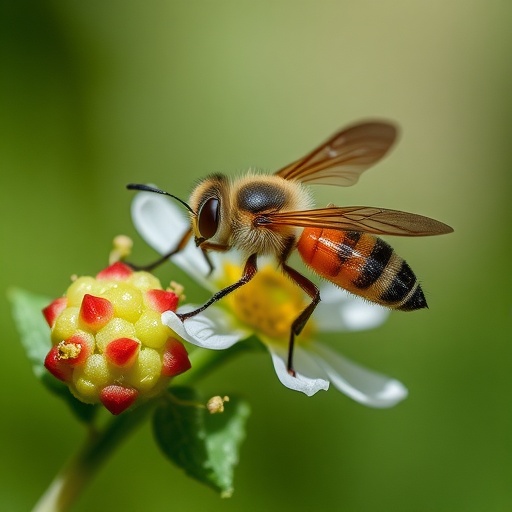In an exciting recent study published in Scientific Naturalists, researchers have sought to unravel the complexities of pollinator effectiveness and their foraging behaviors in relation to the plant species Neustanthus phaseoloides, a member of the Fabaceae family. Pollinators play a pivotal role in ecological systems, influencing plant reproduction and biodiversity, and this research highlights the intricate relationships between these organisms and the plants they service.
The significance of pollinators extends not only to agricultural success but also to the intricate webs of life in which they exist. Understanding their effectiveness provides insight into how these interactions can be preserved and enhanced in changing environments. The research team, led by Dr. S. Paul, conducted an extensive field study and utilized an array of methodologies that included observational studies and quantitative analyses to gauge pollinator visits, behaviors, and their subsequent impact on the reproductive success of Neustanthus phaseoloides.
One notable aspect of the research was the emphasis on different types of pollinators. The study analyzed diverse groups, including bees, butterflies, and various insect species, each contributing differently to the plant’s pollination process. The varied traits and behaviors of these pollinators affect the efficiency with which they transfer pollen. Bees, for example, exhibit specialized foraging methods that optimize their contact with a flower’s reproductive structures, in contrast to other pollinators, which may not be as effective.
Furthermore, the microhabitats where Neustanthus phaseoloides is found were carefully mapped and evaluated. This plant, known for its resilience and adaptivity in various ecological niches, can be found in a range of environments. This variability in habitat allows researchers to assess how local environmental conditions influence foraging behavior amongst different species of pollinators. Consequently, this part of the study offers valuable data that contributes to conservation strategies aimed at protecting both the pollinators and their flowering counterparts.
The researchers meticulously recorded the frequency of pollinator visitations over multiple blooming seasons. These observations indicated a correlation between the diversity of pollinators present and the overall reproductive output of Neustanthus phaseoloides. Specifically, they discovered that the more diverse the pollinator assemblage, the higher the seed set observed in the plants. This finding underscores the importance of maintaining a diverse pollinator community to secure the reproductive success of plant species.
Analyzing this phenomenon extends beyond mere observation. The researchers employed statistical models to delve deeper into the relationships between pollinator behavior, environmental variables, and reproductive success. Factors such as temperature fluctuations, humidity levels, and available resources in the ecosystem were incorporated into their analyses, providing a comprehensive understanding of the conditions that optimize pollinator effectiveness.
Another intriguing dimension of the study was the emphasis on the foraging strategies of different pollinators. Some bees exhibited flower constancy, a behavior where they preferentially visit the same species of flower, thus increasing the efficiency of pollen transfer. Conversely, other insect species displayed more generalist foraging behaviors, visiting multiple flower species indiscriminately. The implications of these differences are profound, suggesting a need for targeted conservation efforts that support both specialized and generalist pollinators.
The research also uncovered the influence of human activity on pollinator populations and plant-pollinator interactions. Habitat degradation, urbanization, and the use of pesticides were identified as critical threats to pollinator effectiveness. The data collected during this study provides a compelling argument for the promotion of sustainable agricultural practices and habitat restoration projects, which could bolster pollinator populations while ensuring agricultural productivity.
In light of global declines in pollinator populations, insights from this study provide crucial frameworks for future research and conservation initiatives. The findings point toward the necessity of integrating ecological, agricultural, and urban planning strategies to facilitate the co-existence of pollinators and plants. This holistic approach might bear significant implications as we face biodiversity loss in the Anthropocene.
The outcomes of this research not only contribute to the academic discourse surrounding pollinator efficacy but also have practical applications in the realms of agriculture and environmental management. Stakeholders, including farmers and policymakers, can utilize this wealth of information to implement strategies that enhance pollinator habitats, thereby increasing crop yields and promoting biodiversity.
In conclusion, the work carried out by Paul, Singha, Roy, and their colleagues on Neustanthus phaseoloides presents a thorough examination of the intricate networks formed between plants and their pollinators. As our understanding of these relationships deepens, it holds the potential to influence a wide range of fields, from biodiversity conservation to sustainable agriculture. Continuous research efforts focused on the dynamics of these interactions will remain vital as we strive to forge a sustainable future that acknowledges and protects the roles of both pollinators and the blooming flora they sustain.
This research serves as a reminder of the delicate balance sustaining ecosystems. By prioritizing the study of such interactions, we can begin to address the broader issues of climate change, habitat destruction, and species extinction that threaten both pollinators and the plants they support. The implications of the findings from this study resonate well beyond the confines of the scientific community, calling for collective action in safeguarding interconnected ecological networks.
Subject of Research: Pollinator effectiveness and foraging behavior on Neustanthus phaseoloides (Fabaceae).
Article Title: The effectiveness of pollinators and their foraging behavior on Neustanthus phaseoloides (Fabaceae).
Article References: Paul, S., Singha, T., Roy, R. et al. The effectiveness of pollinators and their foraging behavior on Neustanthus phaseoloides (Fabaceae). Sci Nat 112, 20 (2025). https://doi.org/10.1007/s00114-025-01971-7
Image Credits: AI Generated
DOI: https://doi.org/10.1007/s00114-025-01971-7
Keywords: pollinators, foraging behavior, Neustanthus phaseoloides, ecological interactions, biodiversity, conservation.




